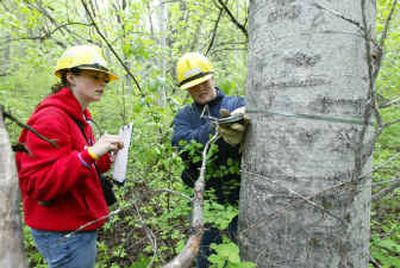Aspen stands in steady decline across West

LEAVENWORTH, Wash. – In a tangle of snowberry brush, vine maple and bitter cherry, and under a canopy of ancient towering aspens, Heather Kranz searched for clues to a disappearing species. The 17-year-old Cascade High School student pushed through the thick underbrush, occasionally dropping to her knees to rustle through damp, musty leaves layered inches thick on the ground.
But she couldn’t find what she was looking for on a cool, overcast morning earlier this month.
In this centuries-old stand of aspens clogged with dense brush and surrounded by mature conifers, Kranz could find no evidence of any new aspen trees sprouting in at least the last two decades.
“I’d say this stand is dying,” she said resolutely. “There’s no new growth. These trees are ancient.”
“Its days are numbered,” said Mick Mueller, an ecologist for the Okanogan and Wenatchee National Forests, as he examined the trees for signs of disease and decay.
Stands of white-barked aspens across the two national forests and throughout the West are facing a similar fate. Their numbers are fading after decades of fire suppression have left the sensitive trees unable to compete in forests overcrowded with pine and fir trees and shrubs.
Historically, frequent, low-intensity fires burned away trees and brush and encouraged new growth in aspen populations, which sprout from a massive, fire-resilient root system, Mueller said. The tree is known for its distinctive bark and fluttering leaves and valued as prime elk, deer and bird habitat.
Without fire or other disturbances, the massive, interconnected root systems that link entire stands of aspens put all their energy into the larger trees, which emit a hormone that suppresses new sprouts. Those trees, which have little tolerance for competition, are slowly being overrun by conifers and shrubs. The root systems, which can live and produce trees for thousands of years, are shrinking.
The majority of aspen stands on the Okanogan and Wenatchee National Forests are now believed to be less than two acres in size.
Until recently, land managers have paid little attention to the tree species, which makes up about 1 percent of all the trees in the two forests. But a study by forest pathologist Jim Hadfield of the Pacific Northwest Forestry Sciences Lab in Wenatchee brought the aspen situation to light last year when he found that nearly half the aspen stands in the two national forests are in a state of decline, and the majority are so small that they are in danger of disappearing.
A few champions of the trees, like Hadfield and Mueller, are determined not to let that happen.
That’s how Kranz and other advanced biology students at Cascade High School ended up surveying aspen stands in the Wenatchee River Ranger District for class credit this spring.
Armed with a GPS unit, measuring stick, tape measure and a clipboard, Kranz and classmates Julianna Simon, 17, and Laauren Martin, 18, spent about four hours studying two aspen stands in the Eagle Creek drainage north of Leavenworth on May 4. They counted trees, recorded the width and overall condition of a sample of them, marked down any evidence of disease or animal damage, and made an educated guess on the number of trees per acre.
One of the stands covering about two acres along Eagle Creek Road had a handful of large conifers blocking the sun. The students found just one new aspen sprouting.
From there, the students walked up a ravine in search of their second survey area. What they found was a strangled stand of aging aspens choked by thick brush and fallen trees. Massive aspens scarred by bear claws towered overhead, stealing most of the nutrients from any potential new sprouts.
The youngest tree Simon and Martin could find was about 20 years old.
“If we don’t do anything here, they will eventually all be gone,” said Mueller, who visited the site with the students.
The two aspen stands are among 30 that students are surveying this spring for the U.S. Forest Service. The agency has little historical data to use for comparison. But the stands are thought to have been considerably bigger in years past, some measuring several hundred acres in size, according to Hadfield’s study.